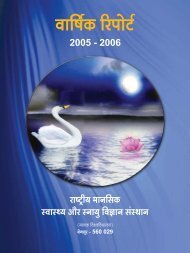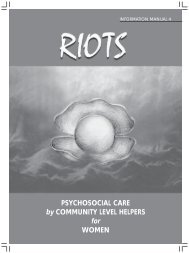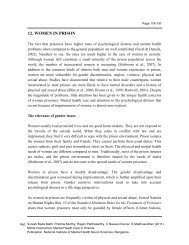An illicit alcohol production center in rural Bangalore - Nimhans
An illicit alcohol production center in rural Bangalore - Nimhans
An illicit alcohol production center in rural Bangalore - Nimhans
You also want an ePaper? Increase the reach of your titles
YUMPU automatically turns print PDFs into web optimized ePapers that Google loves.
Illicit / undocumented beverages were most drunk among the tribal sample, then <strong>in</strong> <strong>rural</strong> areas and<br />
least popular <strong>in</strong> the urban areas. This f<strong>in</strong>d<strong>in</strong>g is along <strong>in</strong>tuitively expected l<strong>in</strong>es. It is no surprise that<br />
extensive availability of both IMFL and cheap country liquor outlets <strong>in</strong> urban areas should dictate<br />
the choice of the urban consumer, rather it is a surprise that despite the vigilance of the excise and<br />
police, despite the ubiquitous presence and reach of the <strong>alcohol</strong> beverage <strong>in</strong>dustry, there should be a<br />
market for <strong>illicit</strong> <strong>alcohol</strong> at all, albeit small.<br />
Apart from the observation that the tribal areas account for the largest prevalence of <strong>illicit</strong> <strong>alcohol</strong><br />
consumption, one must note that the <strong>production</strong> and distribution of beverage <strong>alcohol</strong> <strong>in</strong> these sites,<br />
was considerably different than <strong>in</strong> the <strong>rural</strong> and urban areas. The beverages were most often homemade,<br />
by the women of the house and meant only for personal consumption or at least for a small<br />
group of known consumers. One is also struck by the fact that the procedure for brew<strong>in</strong>g and<br />
distillation and the <strong>in</strong>gredients used, seem not to have changed <strong>in</strong> centuries (Achaya, 1998). Or <strong>in</strong><br />
other words, <strong>in</strong> tribal areas, the <strong>production</strong> and use of beverage <strong>alcohol</strong> appears to be a cont<strong>in</strong>uation<br />
of traditional practice and custom. Not so, <strong>in</strong> the some of the <strong>rural</strong> and more so <strong>in</strong> urban regions<br />
where the <strong>production</strong> is often on the scale of small scale <strong>in</strong>dustries, managed by people for whom<br />
this is not a traditional practice, for profit and <strong>in</strong> league with a crim<strong>in</strong>al nexus. The <strong>production</strong><br />
practices also <strong>in</strong>volve a lot of short cuts and admixture of the beverage with other substances to<br />
give an extra kick. Often, this may result <strong>in</strong> try<strong>in</strong>g to boost the <strong>alcohol</strong> content by add<strong>in</strong>g more<br />
<strong>alcohol</strong>; unfortunately sometimes due to ignorance or greed this may result <strong>in</strong> addition of rectified<br />
spirit or <strong>in</strong>dustrial spirits conta<strong>in</strong><strong>in</strong>g a proportion of methanol.<br />
While it has been customary to expla<strong>in</strong> these <strong>rural</strong> – urban differences <strong>in</strong> <strong>alcohol</strong> use, as a function<br />
of the greater availability of licit <strong>alcohol</strong> <strong>in</strong> urban areas, this does not satisfactorily expla<strong>in</strong> the<br />
<strong>in</strong>creased consumption or normalization of use <strong>in</strong> tribal and <strong>rural</strong> populations compared to urban<br />
groups. Lower economic and educational status certa<strong>in</strong>ly plays a part. However, it is tempt<strong>in</strong>g to<br />
speculate that this is also due <strong>in</strong> no small measure to the process of ‘sanskritisation’ [see section on<br />
Social Economic and political aspects].<br />
Illicitly brewed spirits are over represented among beverages that evade the record<br />
The largest segment of undocumented beverages, were the <strong>illicit</strong>ly distilled spirits. The names and<br />
manufactur<strong>in</strong>g processes varied widely across geographical locations and often <strong>in</strong> the same region<br />
there was a wide variety of beverages available. Illicitly distilled spirits are likely to represent the<br />
largest constituent of the undocumented segment, throughout the country (Carstairs, 1979).<br />
The next large segment was constituted by the seconds liquor. This segment is an important<br />
4.1<br />
18.7<br />
16.4<br />
Distribution: Undocumented beverages<br />
Illicit distilled spirits IMFL seconds Illicit beers and brews Others- smuggled etc<br />
60.8<br />
78





